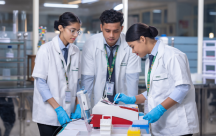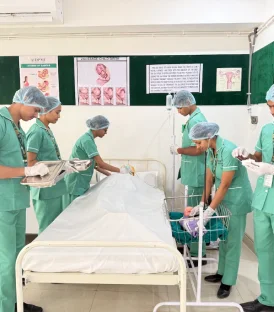August 22, 2022
Upper limb venography is a radiographic examination of upper limb veins in which contrast is injected into the veins of wrist to visualize the abnormalities of the forearm and arm veins.
Indication
- Obstruction in veins due to the blood clot
- Deep vein thrombosis
- Evaluate deep vein valves
- Venous malformation
- Swelling in upper limb
Contraindication
- Hypersensitivity to contrast
- Blood clotting disorder
- Suspected pregnancy
- The patient have asthma and diabetes
Equipment
- Fluoroscopy unit with tilting table
- Contrast
- Butterfly needle
- Antiseptic solution
- Syringes
- Tourniquet
Patient preparation
- The patient should not eat or drink after midnight.
- Patient KFT reports must be reviewed prior to the examination.
- Ask the patient to stop taking anticoagulants before the exam.
- Describe the whole procedure to the patient.
- Ask the patient to remove clothing and wear a hospital gown.
Procedure
- Place the patient in the supine position.
- Clean the area of the patient foot with an antiseptic solution.
- A tourniquet is applied above the ankle to stop blood flow.
- An intravenous line is inserted into the patient’s arm and sedative medication is given through the line to make the patient relax.
- A butterfly needle is inserted into the superficial vein of the wrist then 40 ml of contrast is injected by hands at the rate of 2-4 ml per second.
- The first series of spot films of the forearm is taken immediately after contrast media administration.
- Ask the patient to perform the Valsalva maneuver to delay the transit of the contrast media.
- The second film of the arm is taken after a few seconds in a relaxing Valsalva maneuver.
- In this position, the veins of the arm the basilic, and the cephalic are filled with contrast media.
- Several films of the arm and the shoulder region are taken in anterior-posterior and lateral projection.
- At the end of the procedure, the needle should be flushed with saline to avoid phlebitis.
- After completion of the examination, the butterfly needle is removed, and the dressing is applied to the puncture site of the foot.
Aftercare
- Keep the patient under observation BP, heart rate injected site swelling and other vital signs should be monitored.
Interpretation
- If the venogram shows blood clots or blockage in the veins, special medicine may be given to dissolve the clot or a balloon angioplasty may be performed.
- To widen the vessels and improve blood flow during the angioplasty a metal stent may be placed by the surgeons.

















